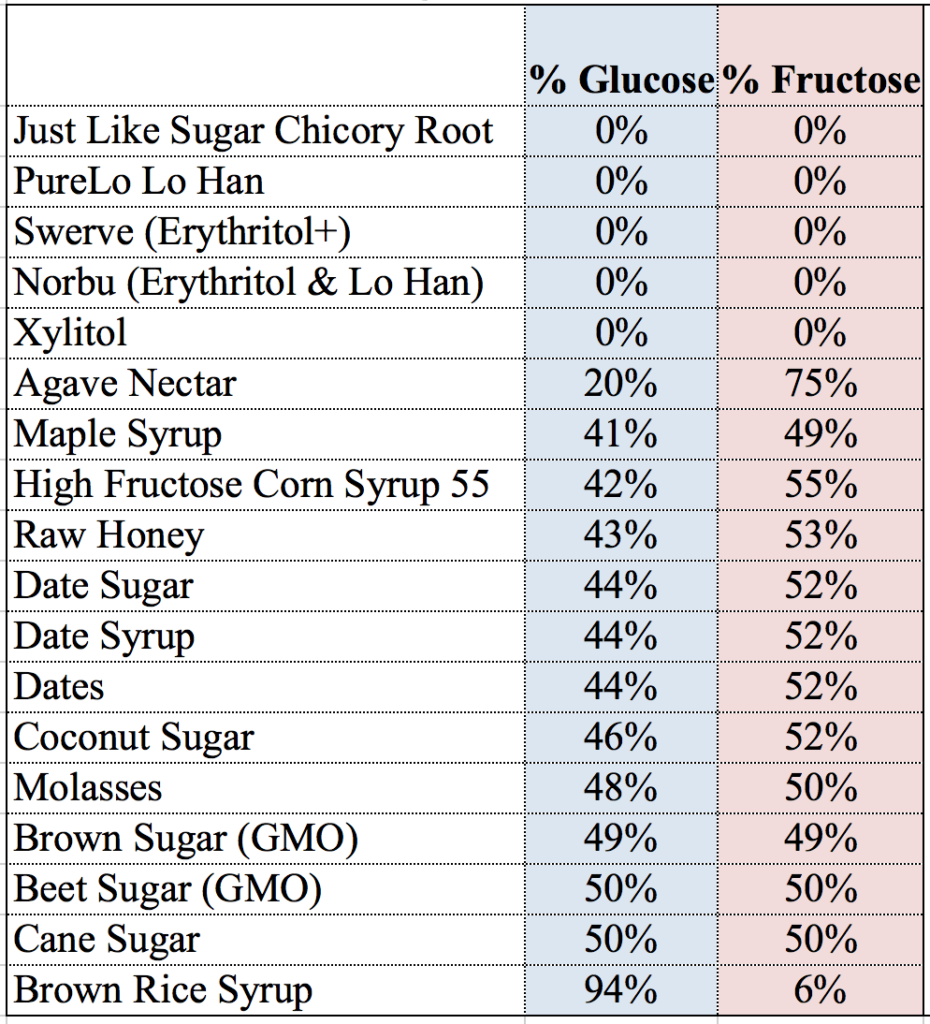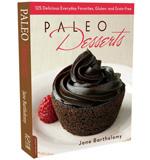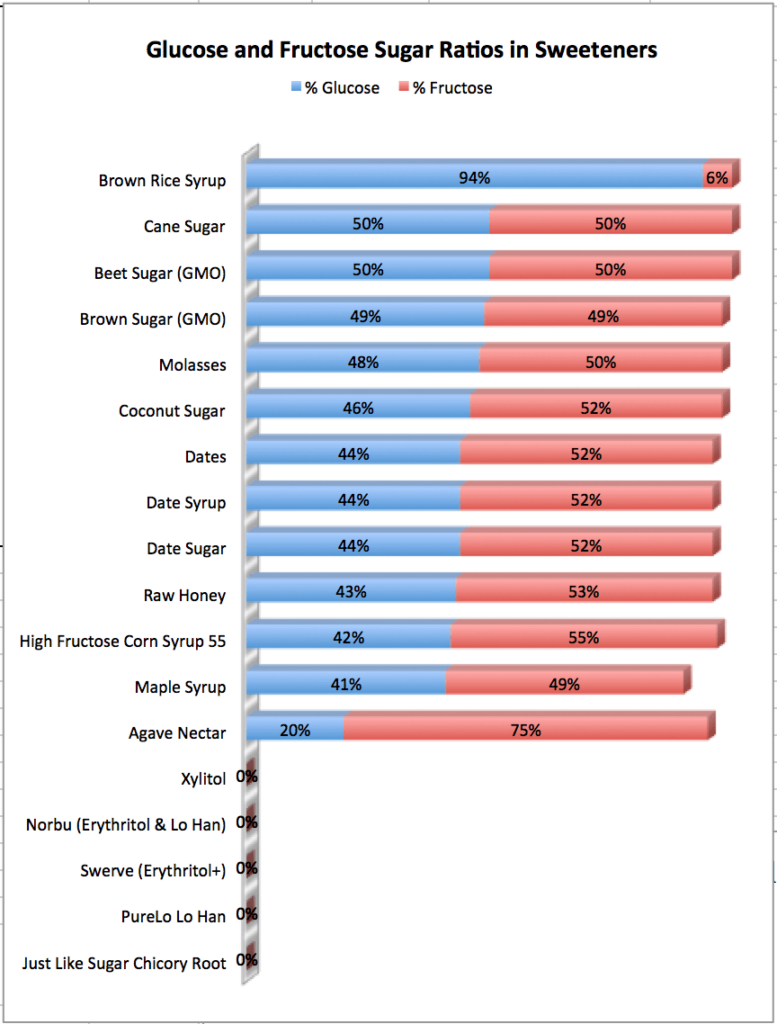BEWARE when a sweetener claims to be “natural” or “low glycemic”. Don’t be fooled. Sugar is sugar no matter what form it’s in. Here’s a little-known secret to help you see clearly through marketing hype: The two primary sugars in foods are glucose and fructose. Most sweeteners are a mixture of both. Both fructose and glucose taste fabulously delicious! Yet they’re both the toxic root of obesity and metabolic mayhem in the body. Together these two sugars cause or exacerbate most of our modern chronic diseases.
High-fructose sweeteners that often claim “low glycemic” include High Fructose Corn Syrup, Agave Nectar, Maple Syrup, Coconut Sugar, Dates, and Date Sugar. Yes, these contain a high ratio of fructose to glucose (see chart below). OK, so what? Since both glucose and fructose are toxic to the body, let’s call a spade a spade and check the total sugar content including both glucose and fructose. Look on the label.
Healthy Sweeteners Without Glucose or Fructose?
Yup, there are just 4 sweeteners I consider safe, that contain neither fructose nor glucose. Not widely known, they’re available in a few groceries and online. We know the sugar cartel is very powerful, so you’re unlikely to find these healthy sweeteners in a big box store. Click on the links below to find them. I don’t sell sweeteners – I just study them. My only four recommendations are:
- Just Like Sugar Table Top chicory root sweetener
- PureLo Lo Han Sweetener by Swanson
- Swerve Sweetener
- Norbu Sweetener, Lakanto
Health risks of glucose and fructose?
Glucose goes into the bloodstream immediately, and raises the glycemic content of your blood. We measure glucose i.e. “glycemic index”. (We have no common index for fructose.) Studies show that high blood glucose is a factor in most chronic illnesses including diabetes, arthritis, heart disease, cancer, inflammation, gut micro-biome imbalance, and Alzheimer’s disease. Glucose is physically addictive, lighting up the same centers of the brain as cocaine.
Fructose does not go directly into the bloodstream. There’s no blood sugar spike, so fructose often feels harmless. However fructose is sneakier. Instead of causing a glycemic rush, it goes to the liver for processing, like any toxin. Fructose is associated with increased risk for high triglycerides, the BAD cholesterol, fungal infections, reduced brain function, weight gain, sugar cravings, and biomarkers for heart disease. Fructose sugars generally lead to increased craving for sweets. Whenever you see marketing claim “low glycemic”, don’t be fooled. It probably means there’s a higher percentage of fructose, which isn’t measured by glycemic index. There’s no “fructemic index”, although we definitely need one. To know the truth, just look at the total sugars.
So which is worse – glucose or fructose?
Well, both these sugars are equally poisonous, in different ways. So what can we do? Learn about alternative sweeteners. We have taste receptors for sweet flavors, and yes, we can enjoy them. We need to be informed about which sweeteners serve our health, and which ones do not.
How can I find the % total sugar in a sweetener?
OK. You’d like to know what percentage sugar represents in any product. The ingredient label will tell you its total sugar content in grams. You have to do some basic arithmetic. Start with the sugar in grams and divide by the serving size in grams. For example, if there are 4 grams sugar, and the serving size is 4 grams, you divide 4/4 and get 1. That means the sweetener is 100% sugar. In some cases you may have to convert the serving size to grams. For example, if there are 16 grams sugar, and the serving size is 4 teaspoons, you must convert the serving size into grams. You do some quick internet searching and find 4 teaspoons of sugar is 16 grams. You divide 16 grams / 16 grams = 1. Aha! You just discovered the sweetener is 100% sugar, however someone apparently tried to conceal that fact.
The ingredient label will NOT tell you the glucose to fructose ratio. You’ll find that in the resources below. But in truth this topic is complicated, as there are other types of sugars like maltose, lactose, along with other non-sugar ingredients in many sweeteners. Don’t worry about it. Sugar is sugar, no matter the form it’s in. Both fructose and glucose are toxic. Just keep it simple and keep your eyes on the total sugar content. Whew! Here are the easy charts below.
Glucose and Fructose Sugar Ratios in Sweeteners

Details:
Raw honey is a sacred, luscious, high-fructose sweetener. And it is mostly sugar. Honey has anti-bacterial properties when used on the skin. It will also give you a nice big blood sugar spike and stress your liver if you eat it. For this reasons I use honey as a rare treat and I do not recommend it for general daily use.
Beware of GMO’s and Glyphosate
Unfotunately Beet Sugar and Brown Sugar are made from GMO beets. Most Erythritol and Xylitol are made from GMO corn stalks – Yuch! Cane sugar and Rice Syrup are non-GMO, however they are usually sprayed with Monsanto’s herbicide Glyphosate, a very dangerous toxin. To avoid both GMO’s and Glyphosate, we need to look for organic sweeteners with neither GMO’s or chemicals.
Xylitol is a fermented sweetener that I do not recommend, because it causes a small sugar spike, creates gas in the intestines, is often made from GMO corn, and causes liver failure in dogs. For more info, see my article: Avoid Xylitol, Deadly to Dogs.
What about Stevia?
Many doctors recommend stevia as a healthy non glycemic sweetener. While they’re correct stevia in its pure form contains neither fructose nor glucose, all stevia drops and powders I studied are highly processed with chemicals, which are not removed in the final product. Check out my detailed article: AVOID! The Toxic Truth About Stevia
The raw unprocessed stevia plant is 100% safe and natural (although with a strong aftertaste). However my research shows that unfortunately all stevia extracts we buy – both drops and powders- are highly processed with chemicals. Yes, they succeeded in removing the aftertaste, but what’s left is extremely toxic. Small amounts won’t kill you, but so many little toxins add up to a big toxic load on your health. Although the original stevia plant is natural, after so much processing with chemicals that are not removed, the stevia we find on the grocery shelves is closer to an artificial sweetener – i.e. poisonous. Even worse, stevia extracts are often mixed with other undeclared additives that are harmful to health. I don’t sell sweeteners. I just study them in the interest of everyone’s health. I’d avoid stevia. The choice is yours.
Sucrose is just another name for table sugar. It is 100% sugar, a combination of 50% glucose and 50% fructose.
Quiz:
- What are the two primary sugars in foods?
- Which sugar does “glycemic” measure?
- What’s the difference between glucose and fructose in the way the body digests it?
- Which is worse for your health, glucose or fructose?
- Which common sweeteners are highest in total sugars? (see the chart)
- Which sweeteners are highest in fructose? (see the chart)
- Your best friend offers you a “natural, low glycemic” energy bar sweetened with dates. How can you find the total sugar content?
- What’s your favorite healthy sweetener, with no glucose or fructose?
Resources:
https://www.ncbi.nlm.nih.gov/pubmed/26338891
https://authoritynutrition.com/agave-nectar-is-even-worse-than-sugar/
http://www.webmd.com/heart/metabolic-syndrome/news/20090421/fresh-take-on-fructose-vs-glucose#1
http://www.latimes.com/health/la-he-sweeteners31-2009aug31-story.html
http://articles.mercola.com/sites/articles/archive/2010/01/02/highfructose-corn-syrup-alters-human-metabolism.aspx
https://www.dietdoctor.com/robert-lustig-the-man-who-says-sugar-is-poison
https://www.ers.usda.gov/data-products/sugar-and-sweeteners-yearbook-tables/
http://www.huffingtonpost.com/dr-mercola/sugar-may-be-bad-but-this_b_463655.html
http://articles.mercola.com/sites/articles/archive/2016/10/12/other-names-for-sugar.aspx
https://www.ncbi.nlm.nih.gov/pmc/articles/PMC4078442/
http://ajcn.nutrition.org/content/88/6/1716S.full
http://articles.mercola.com/sites/articles/archive/2016/09/28/sugar-industry-research-manipulation.aspx
http://foodintolerances.org/fructose-content-of-food/






2 Replies to "Myth-Busting "Natural" Sweeteners. It's about FRUCTOSE, darlin'!"
judy February 25, 2024 (12:35 pm)
is Monk fruit a good low glycemic sweetener
Jane Barthelemy February 25, 2024 (4:33 pm)
Hi Judy, thanks for your comment. Yes! When it is 100% pure, Monkfruit is an excellent zero glycemic sweetener. But be careful as many monk fruit products contain other ingredients. Best wishes for your delicious health! Jane